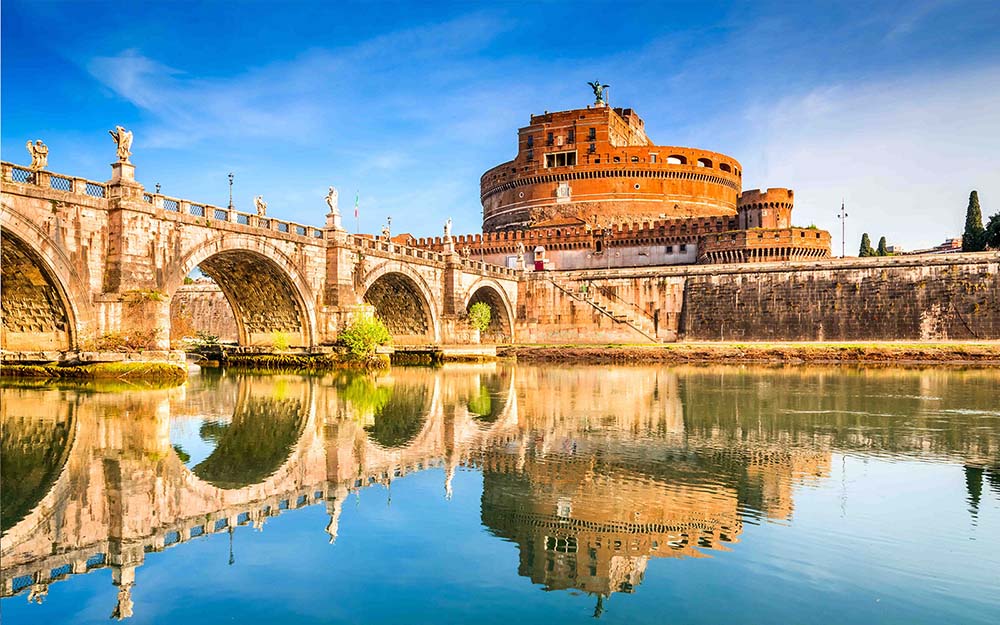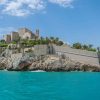Castel Sant’Angelo
Castel Sant’Angelo is one of Rome’s most iconic landmarks. It has stood as a silent witness to the city’s tumultuous history for nearly two millennia. The structure was originally constructed as a mausoleum for Emperor Hadrian and his family. This imposing structure later evolved into a fortress, a papal residence, and a prison. Today, it serves as a museum. Castel Sant’Angelo is located on the banks of the Tiber River. It captivates visitors with its unique blend of Roman, medieval, and Renaissance architecture. The castle’s strategic importance has made it a key feature in Rome’s urban landscape. As a result, it draws tourists and history enthusiasts from all over the world.
Can’t wait to visit the castle? Book your Castel Sant’Angelo tour online.
Location of Castel Sant’Angelo
The location of Castel Sant’Angelo is both strategic and picturesque. It occupies a prominent position on the right bank of the Tiber River. It is just a short distance from Vatican City. The close proximity to the Vatican highlights the castle’s historical significance. The structure served as a refuge for popes during times of political unrest. The Passetto di Borgo connects the castle to the Vatican. Popes used this hidden elevated passage to escape to safety. Visitors will find the castle easily accessible and conveniently located near several of Rome’s historic landmarks. These include St. Peter’s Basilica and Piazza Navona. The castle’s riverside location provides stunning views of the city. The upper terraces, in particular, offer breathtaking panoramas. From here, visitors can gaze out over the Tiber and the rooftops of Rome.

History of Castel Sant’Angelo
Castel Sant’Angelo’s history intertwines deeply with Rome’s own, reflecting the city’s transformations through the ages. Construction of the castle began around AD 135 under the reign of Emperor Hadrian, who intended it as a mausoleum for himself and his family. They interred Hadrian’s ashes, along with those of subsequent emperors, here, making the mausoleum a symbol of imperial power and continuity.
In the 5th century, the mausoleum was transformed into a military fortress to protect Rome from invading barbarian forces. Over the centuries, the structure was fortified and expanded, becoming a key defensive position in the city’s military strategy. After a legend from the 6th century, the name “Castel Sant’Angelo” emerged when Pope Gregory I saw a vision of the Archangel Michael sheathing his sword atop the mausoleum, signaling the end of a devastating plague in Rome. To commemorate this event, they placed a statue of the archangel, which still crowns the castle today.
During the medieval period, Castel Sant’Angelo served as a refuge for popes during times of conflict. The castle’s robust fortifications made it an ideal stronghold against external threats, and the papal apartments within the castle featured the luxuries and comforts befitting the leaders of the Catholic Church. During this period, builders constructed the Passetto di Borgo, the secret passage connecting the castle to the Vatican, which further solidified the castle’s role as a papal fortress.
The Renaissance period saw Castel Sant’Angelo take on additional roles, including that of a prison. The castle imprisoned many notable figures within its walls, including the philosopher Giordano Bruno and the sculptor Benvenuto Cellini. Visitors can still explore the castle’s dungeons, which retain their dark, foreboding atmosphere.

Current status
Today, Castel Sant’Angelo stands as a testament to Rome’s layered history. It serves as both a museum and a popular tourist attraction. The structure has undergone extensive restoration to preserve its historical features. Visitors can explore the many rooms, corridors, and courtyards within the castle. The museum inside Castel Sant’Angelo houses a vast collection of art and military memorabilia. Historical artifacts are also on display. These offer a glimpse into the various phases of the castle’s existence.
Visitors can walk through the papal apartments, which have been beautifully restored. These apartments are decorated with Renaissance frescoes. The Hall of Urns, where the ashes of Roman emperors were once kept, is also on display. The prison cells that held some of the Renaissance’s most important figures are another highlight. The castle’s terraces provide panoramic views of Rome. These offer a perspective that few other sites can match.
Castel Sant’Angelo continues to symbolize Rome’s resilience and adaptability. It embodies the city’s ability to repurpose and preserve its historical landmarks. Whether you are interested in Roman history, medieval fortifications, or Renaissance art, Castel Sant’Angelo offers a rich and diverse experience. This castle is sure to leave a lasting impression. Its central location in Rome makes it an essential stop for anyone wishing to understand the historical and cultural fabric of the Eternal City.
Admission
Community features
Castle features
Video
Location
Official website
Featured listings














